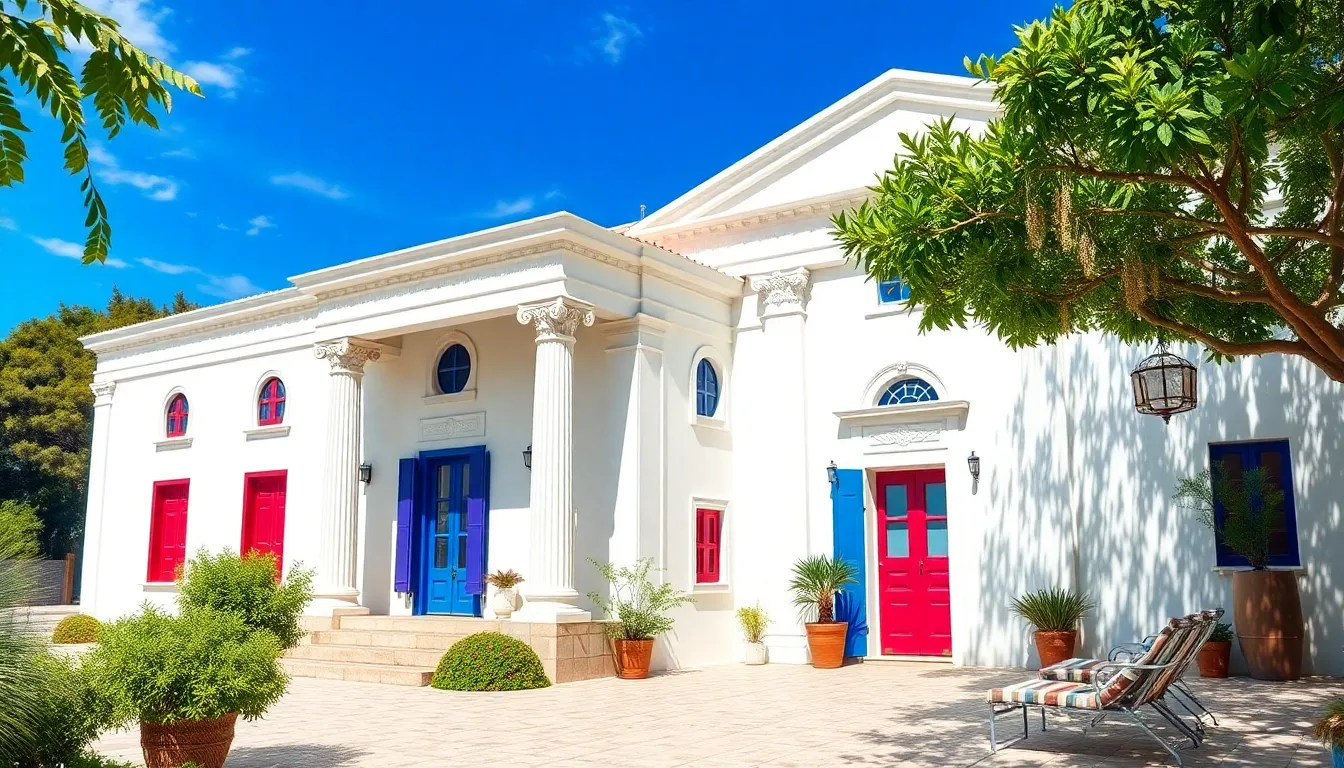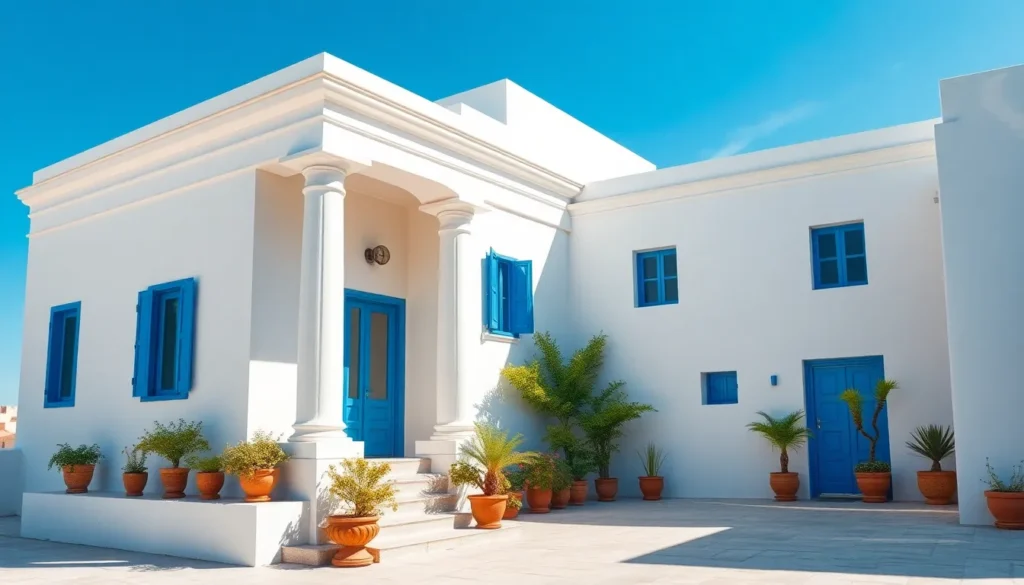Table of Contents
ToggleImagine stepping into a world where ancient history meets modern living. Greek architecture houses are like time machines, whisking you away to the sun-soaked shores of the Mediterranean while keeping your Wi-Fi connection strong. With their iconic columns and stunning facades, these homes don’t just stand out—they practically shout, “Look at me!”
Each detail, from the elegant symmetry to the vibrant whitewashed walls, tells a story of a culture that revered beauty and harmony. Whether you’re dreaming of a cozy retreat or an Instagram-worthy backdrop, Greek architecture has something to offer everyone. Get ready to dive into the enchanting world of Greek homes, where every corner whispers tales of gods, myths, and perhaps a little olive oil magic.
Overview of Greek Architecture
Greek architecture showcases a unique blend of form and function, often reflecting the country’s cultural priorities. Classical Greek structures divided into three main styles: Doric, Ionic, and Corinthian. Each style features distinct characteristics, with Doric being the simplest and most robust, Ionic being more ornate, and Corinthian style known for its elaborate details.
Columns play a pivotal role in Greek architectural design. Doric columns exhibit a sturdy appearance, while Ionic columns present scroll-like designs at the capitals. Corinthian columns elevate opulence with intricate foliage patterns. These elements not only support structures but also symbolize strength, beauty, and harmony, values deeply rooted in Greek culture.
Additionally, buildings such as temples and theaters highlight the architectural ingenuity of ancient Greece. The Parthenon, a temple dedicated to Athena, exemplifies the mastery of symmetry and proportion. Amphitheaters, like those in Epidaurus, demonstrate an understanding of acoustics and community engagement, allowing audiences to connect with performances.
Materials also hold significance in Greek architecture. Limestone and marble served as primary building blocks for many structures. Environmental considerations influenced material choices, resulting in durable yet aesthetically pleasing designs.
Modern Greek homes draw inspiration from this rich architectural heritage. Whitewashed walls reflect sunlight, creating bright living spaces while remaining practical in a warm climate. Open layouts encourage flow and connection with the surrounding environment, blurring the line between indoor and outdoor living.
Greek architecture combines timeless beauty with practicality. It continues to inspire contemporary design, ensuring that its legacy remains vibrant in modern interpretations of Greek homes.
Characteristics of Greek Architecture Houses

Greek architecture houses reflect a rich history while merging classical design with modern comforts. These structures showcase distinct elements and decorative features that define their uniqueness.
Structural Elements
Columns form the backbone of Greek architecture houses. Doric columns represent simplicity with sturdy proportions. Ionic columns display sophistication through elegant scrolls. Corinthian columns stand out with intricate details, emphasizing grandeur. Roofs often feature sloping designs to shed rain efficiently. The utilization of limestone and marble in construction ensures durability and aesthetic appeal. Whitewashed walls enhance light reflection, creating bright interiors. Open layouts promote air circulation, connecting indoor and outdoor spaces seamlessly.
Decorative Features
Decorative features elevate the beauty of Greek architecture houses. Friezes adorned with sculptural reliefs capture mythological scenes and everyday life. Artwork often emphasizes harmony and balance, consistent with Greek ideals. Windows framed in vibrant colors provide contrast against the white exteriors. Terraces invite outdoor living, ensuring residents enjoy beautiful views. Mosaic tiles add artistic flair underfoot, incorporating colorful patterns. Shaded courtyards offer tranquil retreats, blending nature and architecture harmoniously.
Historical Significance of Greek Architecture Houses
Greek architecture houses reflect a rich cultural heritage that dates back to ancient times. These structures not only showcase artistry but also embody the values of beauty, harmony, and functionality. The use of three distinct column styles—Doric, Ionic, and Corinthian—illustrates the evolution of architectural sophistication throughout history. Each style contributes uniquely to the aesthetic appeal and structural integrity of buildings.
Ancient Greek homes often served multiple purposes, acting as family dwellings, community centers, and places for worship. This multifunctionality underscores the significance of architecture in social and cultural contexts. The robust use of materials like limestone and marble emphasizes durability, which remains a hallmark of Greek design, impacting architectural trends across centuries.
Significant examples such as the Parthenon exemplify advanced engineering techniques of the time, establishing benchmarks for future civilizations. Amphitheaters, designed for large gatherings, highlight community engagement, showcasing the social aspect of architecture. The focus on open layouts encourages a strong connection to the surrounding environment, resonating with contemporary design ideals.
Cultural symbols are often integrated into the designs, with decorative elements like friezes and mosaics reflecting local heritage and artistic expression. Iconic features such as sloping roofs and shaded courtyards provide practical solutions to climate challenges, ensuring comfort. These enduring characteristics merge traditional aesthetics with modern living requirements, ensuring that Greek architecture houses remain relevant today.
Overall, the historical significance of Greek architecture houses lies in their ability to connect past and present, enriching modern lifestyles while preserving a sense of identity rooted in ancient civilizations.
Notable Examples of Greek Architecture Houses
Greek architecture houses showcase a harmonious blend of ancient design and contemporary living, exemplifying cultural significance and aesthetic appeal.
The Parthenon
The Parthenon stands as a paramount example of Doric architecture. Built in the 5th century BCE, it symbolizes the height of ancient Greek civilization and artistic achievement. The structure features iconic fluted columns and an elaborate pediment. Constructed from fine white marble, the Parthenon reflects the finesse and skill of its architects. Additionally, it served as a temple dedicated to the goddess Athena, further highlighting its cultural importance. Preservation efforts ensure that today’s visitors can experience its grandeur. As one of the most recognized structures globally, the Parthenon continues to inspire modern architects and designers.
Traditional Greek Island Homes
Traditional Greek island homes exemplify simplicity and elegance. These structures feature whitewashed exteriors that blend seamlessly with the surrounding landscape. A flat roof characterizes many buildings, designed to collect rainwater effectively. Vibrant blue window frames and doors add splashes of color to the pristine facades. Additionally, the use of local stone ensures durability and resilience against Mediterranean elements. Terraces often overlook stunning sea views, creating a serene living environment. These homes prioritize natural light and ventilation, enhancing comfort. While rooted in history, traditional Greek island homes continue to influence modern architectural designs, celebrating the beauty of the Aegean.
Influence on Modern Architecture
Greek architecture significantly influences modern architectural designs, blending classical aesthetics with contemporary needs. Iconic elements like columns, grand entrances, and open spaces resonate in many modern structures, illustrating a commitment to beauty and functionality.
Incorporation of natural materials, such as stone and marble, remains prevalent in today’s building practices, reflecting the enduring legacy of ancient craftsmanship. Home designs often feature whitewashed exteriors, mirroring the traditional Greek island houses, which emphasize simplicity and harmony with the landscape.
The principles of proportion and symmetry, essential in Greek design, also enhance the visual appeal of modern buildings. Modern architects frequently adopt these classical ideals, ensuring cohesive and balanced structures.
Cultural symbols from Greek architecture inspire decorative elements in various contexts, creating a dialogue between the past and present. Pai, intricate friezes, and mosaic tiles often appear in contemporary renovations, providing a nod to the historical significance of ancient styles.
Moreover, open floor plans and integration of outdoor spaces mirror the spatial arrangements found in traditional Greek homes, promoting a connection with nature. This strong relationship with the environment reflects a sustainable approach prevalent in modern architectural trends.
Consequently, notable examples such as public libraries, museums, and civic buildings draw directly from Greek architectural principles, emphasizing community engagement and social interaction. Structures inspired by the Parthenon serve not only as landmarks but also enhance community identity.
Overall, the influence of Greek architecture on modern designs demonstrates its timelessness, merging historical significance with the comforts of contemporary living.
Greek architecture houses embody a timeless elegance that continues to inspire both homeowners and architects. Their unique blend of history and modernity creates spaces that are not only visually stunning but also functional. By incorporating elements like iconic columns and whitewashed walls, these homes reflect a deep cultural heritage while embracing contemporary comforts.
As modern designs evolve, the principles of Greek architecture remain relevant, emphasizing beauty, harmony, and sustainability. The enduring influence of this architectural style ensures that it will continue to shape living environments for generations to come, celebrating the rich stories and traditions that define Greek culture.







